Despite its rich mythology featuring sea monsters, Greece isn’t typically the first place to come to mind as a hotspot for shark encounters. However, these magnificent marine creatures do inhabit the waters surrounding this Mediterranean nation. Though with that said, shark encounters are definitely less common here than in other areas. Spotting one of these great marine creatures may be the perfect highlight of your summer trip!
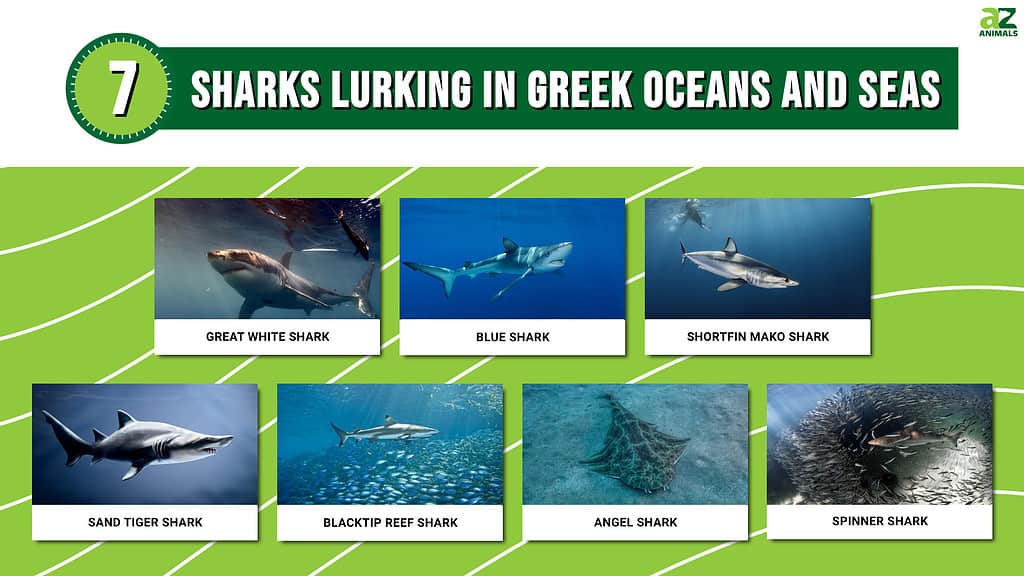
In this article, let’s dive in and get to know 7 sharks that inhabit Greek oceans and seas. We’ll shed light on their appearance, behavior, and more. We will also discuss the most likely locations for sightings.
Great White Shark (Carcharodon carcharias)
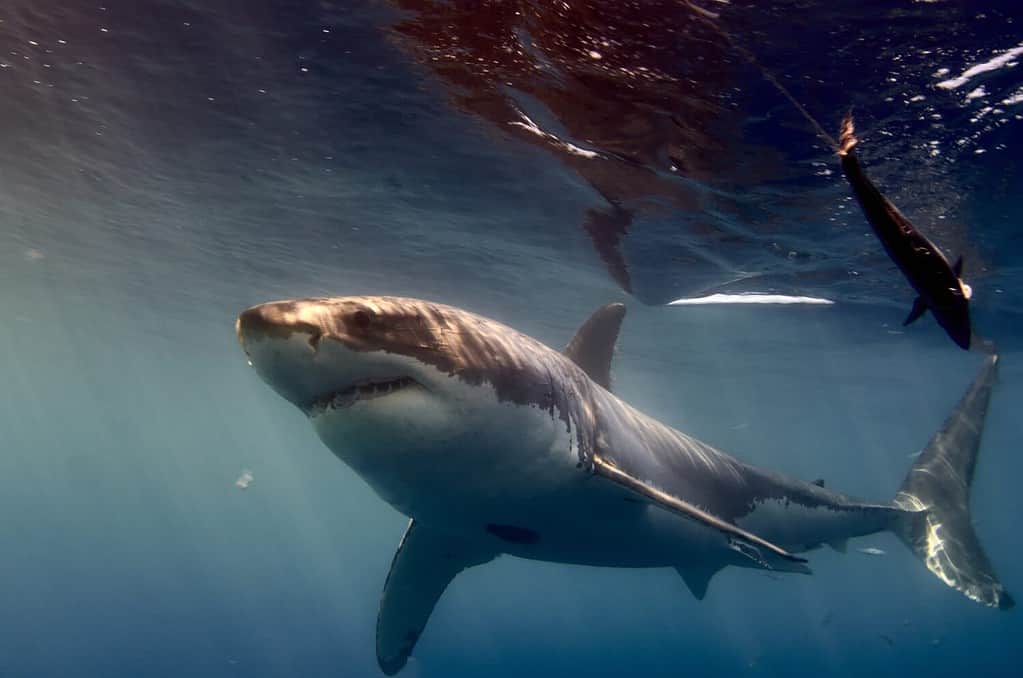
One of the most famous species of shark in Greece is the great white shark.
©Wirestock Creators/Shutterstock.com
The great white shark is a notable species that lives and wanders around in the waters surrounding Greece. However, with that said, sightings are relatively rare. As one of the biggest predatory sharks, it can reach lengths of up to 19 feet or more. This impressive and famous shark has a robust and streamlined body. It features a dark gray or blue-gray coloration on its upper side, blending into a lighter shade on its ventral side (underside). It also has a powerful, crescent-shaped tail and rows of serrated teeth that aid in capturing and consuming its prey.
The great white shark is an apex predator with a diverse diet. Its diet primarily consisting of marine mammals such as seals and sea lions. It also feeds on various fish species, including rays and smaller sharks. Utilizing its exceptional speed and agility, the great white shark employs a hunting strategy known as “ambush predation.” To surprise and capture its prey, it launches powerful bursts of speed.
This species of shark typically inhabits coastal regions, including parts of the Mediterranean Sea. While they can venture into deeper offshore waters, great white sharks are more commonly associated with nearshore environments, including areas close to rocky coastlines and seal colonies.
Despite its portrayal in popular media, incidents involving great white sharks and humans are rare. They generally do not actively seek out humans to eat. In fact, most incidents involving great white sharks and humans are accidental or cases of mistaken identity.
Blue Shark (Prionace glauca)
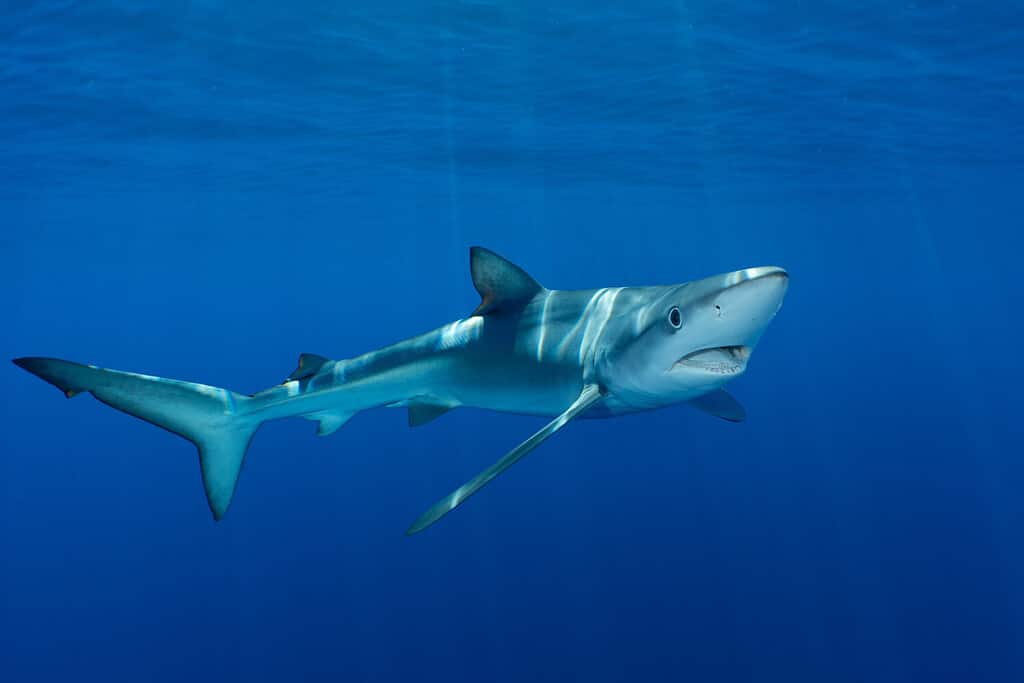
The pointed snout and large eyes of the blue shark give it an almost cutesy appearance.
©Samy Kassem/Shutterstock.com
The blue shark is another unique shark species in Greece. It has a slim, streamlined body and vibrant indigo-blue coloration that fades to a lighter hue on its underside. In terms of size, the blue shark can reach lengths up to 13 feet long.
The blue shark’s distinctively long, slender body and elongated pectoral fins allow it to navigate the waters with ease. The pointed snout and large, round eyes give it an almost delicate and cutesy appearance. But despite its cute look, the blue shark is still a highly effective predator.
Blue sharks are pelagic creatures, meaning they inhabit the open ocean rather than coastal areas. They thrive in cooler waters and are known for their extensive migrations, which can take them across entire oceans. Their habitat is virtually worldwide, with their presence also reported in the waters surrounding Greece.
When it comes to their diet, blue sharks are somewhat picky eaters. They feed on a diverse menu that includes squid, fish, and smaller sharks. However, sometimes, they may also scavenge on the carcasses of larger marine animals. Their sharp, serrated teeth are perfect for cutting through the flesh of their prey.
Blue sharks are generally not considered a direct threat to humans due to their preference for deep, open waters. However, blue sharks may have been involved in several attacks on victims of shipwrecks or air crashes in the past.
Shortfin Mako Shark (Isurus oxyrinchus)
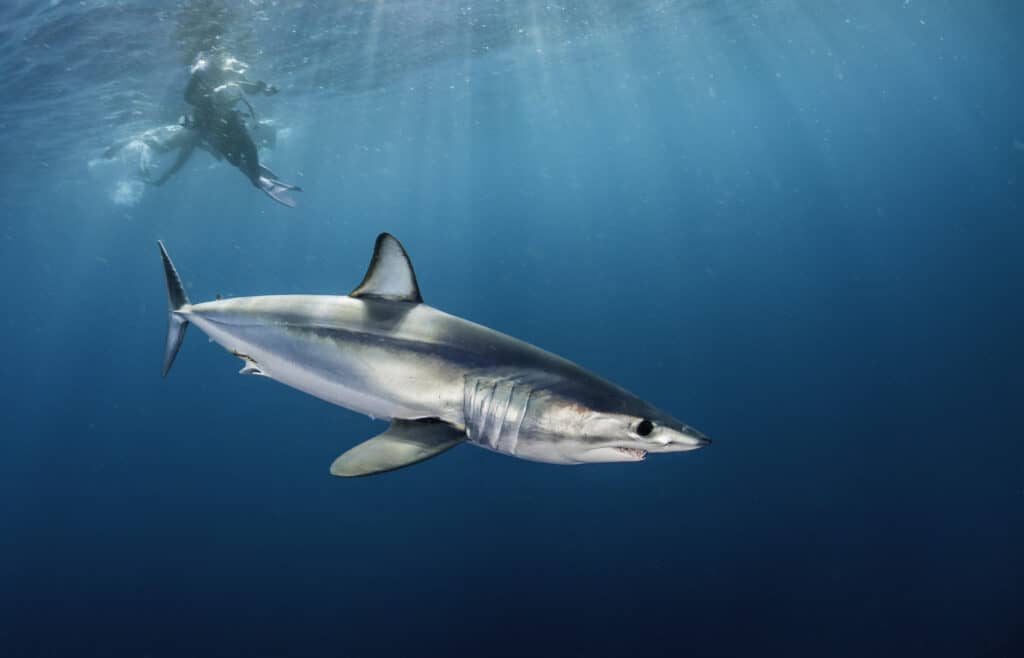
Known for its speed, the shortfin mako shark can be as fast as 46 mph!
©wildestanimal/Shutterstock.com
The shortfin mako shark is one of the fastest sharks in the ocean and is incredibly agile. This shark species can reach lengths of up to 13 feet and possesses a streamlined body built for fast swimming. It moves at speeds of 31 mph (50 kph), but bursts can be as fast as 46 miles per hour! The shortfin mako shark’s slender, torpedo-shaped form aids in moving through the water efficiently. This shark is a metallic blue or dark gray in color on the upper side and a white underside.
As an apex predator, the shortfin mako shark has a diverse diet, including various fish species such as mackerel, tuna, and swordfish. It has powerful jaws filled with long, sharp teeth that enable it to capture and consume its prey with precision. With its exceptional swimming abilities, the shortfin mako can chase down and overtake fast-swimming fish.
The habitat of the shortfin mako shark extends across both offshore and pelagic regions. It can be found in open ocean areas, including the Mediterranean Sea, where Greece is located. These sharks prefer warmer waters but they may also venture into cooler, temperate regions. They are highly migratory and have been recorded traveling vast distances during their lifetime.
While the shortfin mako shark is an impressive and formidable predator, it rarely threatens humans. Encounters with these sharks are infrequent, and they typically exhibit shy and cautious behavior toward humans.
Sand Tiger Shark (Carcharias taurus)
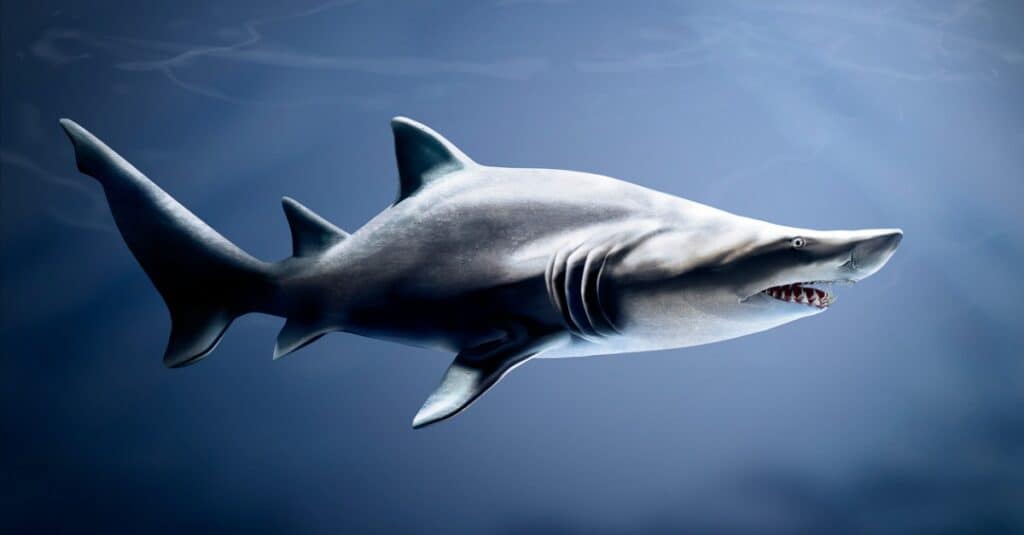
Sand
tiger
sharks have sharp, protruding teeth.
©iStock.com/mirror-images
Despite its intimidating appearance, with a mouthful of protruding teeth, the sand tiger shark is generally docile and poses little threat to humans unless threatened. This shark species typically reaches lengths of around 10 feet. It has a robust and stout body, characterized by a grey-brown coloration on its upper side and a lighter underside.
One of the distinctive features of the sand tiger shark is its sharp, protruding teeth, which give it a fearsome appearance. Interestingly, these sharks do not use their teeth to tear prey. Instead, they use them to grasp and hold onto slipper prey items such as fish and squid. The sand tiger shark has a diverse diet that also includes a variety of other prey, including bony fish, rays, small sharks, and even crustaceans.
The sand tiger shark is primarily found in coastal waters and around reefs, often inhabiting areas with sandy or muddy bottoms. This shark species can tolerate various water temperatures and frequent shallow and deeper waters. While you are less likely to encounter the sand tiger shark compared to other shark species, the sand tiger shark contributes to the biodiversity of Greece’s marine ecosystem.
Unfortunately, conservation efforts are crucial for the sand tiger shark. This shark’s slow reproductive rate and susceptibility to overfishing make it vulnerable to population decline.
Blacktip Reef Shark (Carcharhinus melanopterus)
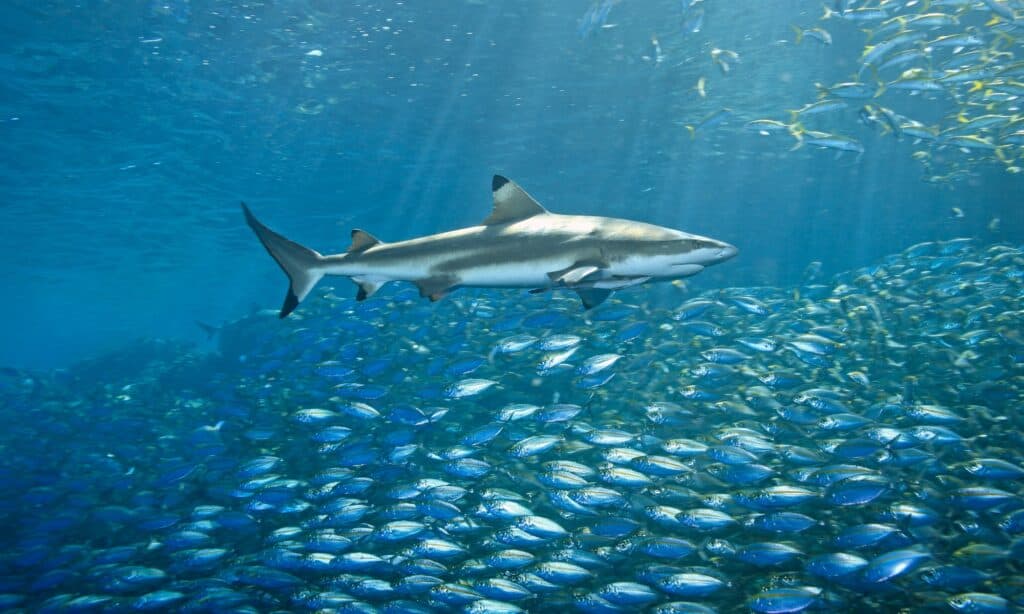
These sharks generally grow up to 6 feet long.
©iStock.com/cbpix
The blacktip reef shark is a shark species with a sleek appearance and unique coloration. These sharks typically grow to about 6 feet long, although larger individuals have been recorded in the past, up to 8 feet. They are easily identified by the characteristic black tips or edges on their dorsal and caudal fins, contrasting sharply with their light grey or brownish bodies. This color pattern gives them their name and serves as excellent camouflage against potential threats in their natural habitat.
As for their diet, blacktip reef sharks are carnivorous predators with a menu that primarily consists of small fish, including wrasses, surgeonfish, and mullets. Occasionally, they supplement their diet with crustaceans, octopuses, and squid. They are known for their speed and agility in the water, making them effective hunters within their marine environments.
The habitat of the blacktip reef shark is predominantly in the shallow, inshore waters of the tropical and subtropical regions across the globe. They are frequently found in and around coral reefs, as evidenced by their name, where the combination of warm water, abundant food sources, and hiding places suits their lifestyle perfectly. Blacktip reef sharks are relatively sedentary despite their potential mobility, often staying within a particular locale for extended periods.
The blacktip reef shark is not considered a significant threat to humans due to its size and timid nature, often choosing to swim away when humans are present. However, like any wild animal, they may react defensively when threatened.
Angel Shark (Squatina squatina)

Resembling a ray rather than a shark, the angel shark is a unique species of shark.
©LuisMiguelEstevez/Shutterstock.com
The angel shark is an intriguing species that defies the typical shark image. It has a unique flattened body and broad pectoral fins. In fact, this shark more closely resembles a ray or a skate, earning it the common name of “monkfish” in some regions. Angel sharks can reach up to roughly 8 feet in length and weigh up to 180 pounds. Their broad bodies exhibit a variety of coloration ranging from grey to brown, often with scattered white spots or blotches. This coloration helps them to effectively camouflage in their sandy or muddy environments.
The angel shark is an ambush predator. Its diet is primarily made up of fish, including flatfish and skates, and it also eats crustaceans and cephalopods. With a flat body and large pectoral fins, the angel shark buries itself in sediment on the ocean floor and waits patiently for prey to swim by. When an unsuspecting creature ventures too close, the shark lunges forward and snaps it with its strong jaws in milliseconds.
These unique creatures are most commonly found in shallow, coastal waters of the northeastern Atlantic Ocean, ranging from the British Isles to the Canary Islands and the Mediterranean Sea. Unfortunately, the angel shark is now listed as critically endangered by the IUCN, most likely due to commercial fishing. Nowadays, efforts are underway to protect and conserve this intriguing species and its habitat.
Despite their formidable hunting skills, angel sharks are considered harmless to humans unless provoked. Their peculiar appearance and fascinating predatory tactics add an interesting twist to the diversity of shark species.
Spinner Shark (Carcharhinus brevipinna)

With its ability to leap out of the water and spin in mid-air, the spinner shark is incredibly agile and acrobatic.
©Lewis Burnett/Shutterstock.com
The spinner shark is another shark species found in the waters of Greece. This shark is known for its remarkable agility. Specifically, the spinner shark can leap out of the water and spin in mid-air, which is where it gets its name. This shark typically reaches a length of around 8 feet. The spinner shark possesses a streamlined body with a grayish-bronze coloration on its upper side and a white underside.
As an opportunistic predator, the spinner shark has a varied diet consisting mainly of small school fish such as sardines, anchovies, and herrings. It employs its unique hunting strategy by swiftly swimming through schools of fish, spinning and snapping its jaws to catch its prey. This behavior allows it to engulf multiple fish in a single attack.
Spinner sharks prefer warm, coastal waters and are commonly found in the Mediterranean Sea, including the waters surrounding Greece. They inhabit inshore and offshore areas, including shallow bays, estuaries, and the open ocean. These sharks are highly migratory, following seasonal changes in water temperature and food availability.
While spinner sharks may exhibit impressive aerial displays, they generally pose minimal threat to humans. As with encounters with other wild animals, exercise caution and respect if you come across these sharks.
The spinner shark’s unique hunting techniques and presence in the Greek waters add to the diverse array of marine life in this region, making it an exciting species for researchers and enthusiasts alike.
Where to Spot Sharks in Greece
The Aegean Sea, Greece’s magnificent body of water that separates the mainland from the myriad of islands, is the country’s most common location for shark sightings. Bordered by Greece and Turkey, the Aegean Sea is a part of the Mediterranean Basin.
The warmer waters of the Aegean Sea and the coastline can attract a variety of different marine life, including many species of sharks, such as the ones listed above. While sightings are still relatively rare, the chances of encountering a shark increase in these waters rather than in other waters in Greece. This is especially true during the warmer summer months when the sharks venture closer to the coast. Scuba divers, fishermen, and even your average beachgoers are more likely to spot these fascinating creatures in the Aegean Sea, contributing to its reputation as a hotspot for shark encounters in Greece.
Some of the best areas to spot sharks in Greece are the regions around Athens, which have recorded a relatively high number of shark sightings in the past. Other recent sightings include a blue shark on Karathonas Beach in Nafplio as well as an unidentified shark on Kos Island.
Shark Attacks in Greece
While shark attacks in Greece are sporadic, isolated incidents have been reported in regions such as Corfu and Attica. Renowned for its breathtaking beaches and lively underwater ecosystem, Corfu, a captivating island situated in the Ionian Sea, draws a significant crowd of travelers every summer. Similarly, Attica, home to the capital city of Athens and several picturesque coastal towns has had occasional reports of shark sightings.
Notably, most encounters are non-aggressive, and sharks attacking humans are infrequent. Though few and far between, these incidents underscore the importance of vigilance and adherence to safety guidelines while swimming or diving in these areas. These rare incidents should not deter visitors from enjoying Greece’s beautiful beaches and marine life. By practicing common sense and adhering to safety guidelines, visitors and travelers can safely enjoy their time in the water.
Summary of Sharks Lurking in Greek Oceans and Seas
| Shark | Scientific Name | |
|---|---|---|
| 1 | Great White Shark | Carcharodon carcharias |
| 2 | Blue Shark | Prionace glauca |
| 3 | Shortfin Mako Shark | Isurus oxyrinchus |
| 4 | Sand Tiger Shark | Carcharias taurus |
| 5 | Blacktip Reef Shark | Carcharhinus melanopterus |
| 6 | Angel Shark | Squatina squatina |
| 7 | Spinner Shark | Carcharhinus brevipinna |
The photo featured at the top of this post is © Samy Kassem/Shutterstock.com
Thank you for reading! Have some feedback for us? Contact the AZ Animals editorial team.






